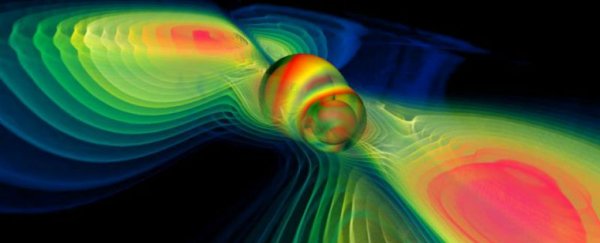Earlier today, well-known American theoretical physicist Lawrence Krauss tweeted that the results of a recent experiment looking for gravitational waves have finally been peer-reviewed and we just might have the first direct evidence that these light-speed ripples in the Universe actually exist.
If it turns out that we really do have definitive evidence that gravitational waves exist - the results of the study have not yet been released to the public - we're looking at Nobel Prize-worthy stuff, but the team behind the experiment is urging everybody to be patient and not to jump to conclusions just yet, despite what's going on in your Twitter feed.
"The official response is that we're analysing the data," Gabriela González, a physicist from Louisiana State University and spokesperson for the LIGO (Laser Interferometer Gravitational Wave Observatory) group that ran the experiments, told Nature when rumours started flying back in September.
Despite Krauss spilling the beans today that independent verification of the results is now complete, the response from the staff at LIGO has not changed. "I'd say that it is wisest to just be patient," one of the LIGO team, Alan Weinstein, told Jennifer Ouellette at Gizmodo, adding that all they're willing to say is that they're analysing the data and will share the news when they're ready.
My earlier rumor about LIGO has been confirmed by independent sources. Stay tuned! Gravitational waves may have been discovered!! Exciting.
— Lawrence M. Krauss (@LKrauss1) January 11, 2016
So until the results are published, nothing's been confirmed, so we can't get too carried away just yet. But what if Krauss's excitement is justified and the LIGO team really has made the first direct observations of gravitational waves?
Predicted by Einstein back in 1916, gravitational waves are ripples in the curvature of spacetime that emanate from the most explosive and violent events in the Universe, such as a star exploding or a black hole merger. Those pictures of space you see with a giant, curvy grid superimposed over the top of everything? That's our way of visualising the influence of gravitational waves.
They're thought to have originated during the Big Bang 13.8 billion years ago, and just like ripples spreading through a pond after a stone's been thrown in, theory states that gravitational waves carry energy from catastrophic events throughout the Universe as gravitational radiation.
According to Einstein's general theory of relativity, gravitational waves explain how mass in the Universe influences the shape of space. Thanks to gravitational waves, the fabric of spacetime around anything that's particularly massive can become curved, and this curviness can then ripple out elsewhere in space, like how seismic waves propagate in Earth's crust.
The problem with gravitational waves is that until now (possibly…), no one's been able to directly observe them. Everything we know about this fundamental influence on the Universe is from what we've been able to glean from indirect observations of what we think are the effects of gravitational waves on various objects in space.
This is because in the enormity of space, the trickle-down effects of even the most humungous explosions are incredibly tiny when you're looking at an individual star, planet, or human being, as Maddie Stone explains at Gizmodo.
"For all the energy that goes into producing gravitational waves, spacetime ripples themselves are incredibly faint," she says. "Physicists estimate that by the time gravitational waves reach Earth, they're on the order of a billionth the diameter of an atom. You need ridiculously precise instruments operating in completely noise-free environments to measure them, and until very recently, our detectors simply haven't been up to snuff."
But maybe LIGO is. This ground-based observatory in Louisiana recently launched the world's first space-based gravitational wave detector, called the LISA Pathfinder, and the might of these two facilities combined could be enough to detect these minuscule ripples.
At this point, we'll just have to wait and see, but with other scientists willing to name gravitational waves as their #1 prediction for scientific discoveries in 2016, we could really be onto something here, and that something would be one of the biggest things to happen in physics in the last century.
"I guess I'd say that rumours just reflect how excited we all get about the prospect of new discoveries," Loyola University physicist, Robert McNees, told Gizmodo. "The best way to support these scientists is to let them carry out their experiments and analysis the way they were meant to be done. Let them take the time to do things the right way!"
Watch this space.
